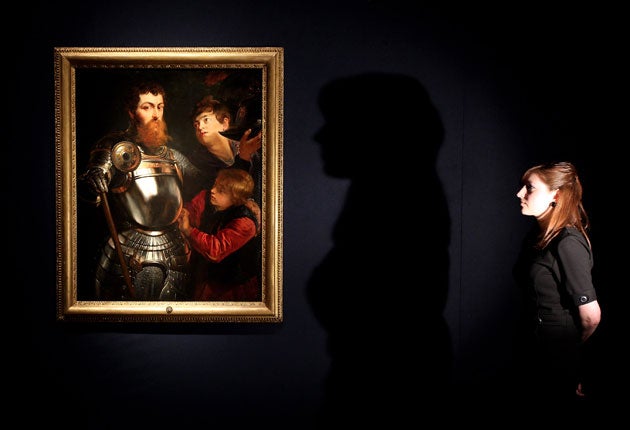On their uppers: The great aristocratic art sell-off
Britain's art galleries lose Old Masters as the owners of stately homes struggle to maintain run-down ancestral homes

Your support helps us to tell the story
From reproductive rights to climate change to Big Tech, The Independent is on the ground when the story is developing. Whether it's investigating the financials of Elon Musk's pro-Trump PAC or producing our latest documentary, 'The A Word', which shines a light on the American women fighting for reproductive rights, we know how important it is to parse out the facts from the messaging.
At such a critical moment in US history, we need reporters on the ground. Your donation allows us to keep sending journalists to speak to both sides of the story.
The Independent is trusted by Americans across the entire political spectrum. And unlike many other quality news outlets, we choose not to lock Americans out of our reporting and analysis with paywalls. We believe quality journalism should be available to everyone, paid for by those who can afford it.
Your support makes all the difference.The family silver has always proved a handy standby for aristocrats hitting hard times. But spare a thought for the current generation of earls and dukes. Things are so tight they are having to flog the pictures off the walls and the furniture from the living room. Charles, Earl Spencer and brother of Diana, Princess of Wales, is selling two Old Masters that have hung on the walls of Althorp, the family's stately home in Northampton, since the early 19th century.
The auctioneers Christie's announced last week that Rubens' A Commander Being Armed for Battle, first acquired by the Spencers in 1802, will be auctioned in the summer, along with King David, by Il Guernico, bought by the First Earl Spencer in 1768. The two works are among 500 lots from Althorp and are expected to fetch up to £12m and £8m respectively, helping to raise the £30m needed to fix the roof and carry out other restoration work.
Spencer is not the only duke with big bills. Last month Sotheby's boasted it would be handling the sale of "one of the most important Turners ever to come to auction". Modern Rome – Campo Vaccino is expected to fetch up to £18m. It was bought by the fifth Earl of Rosebery in 1878 and is being sold by a descendant.
There are normally three reasons for selling family treasures: to pay death taxes, to free up money to pay for repairs or simply to raise cash. The credit crunch has seen Old Masters return to prominence on the art market due to their long-lasting investment potential. But the sales are also raising fears that Britain's heritage is being shipped abroad. In December, the Christie family (no relation to the auctioneers) who run the Glyndebourne opera festival at their 700-year-old stately home in Sussex sold Il Domenichino's St John the Evangelist for £9.2m. The Government has since slapped a temporary export bar on the painting, giving British galleries a chance to buy it. Professor David Ekserdjian, of the Government's Reviewing Committee, which examines art sales, said: "It is the best work by the artist remaining in private hands and its departure from the UK would be lamentable."
An export ban has almost been placed on Rubens' Head of a Muse, sold at the same auction for £29.2m by the heirs of the collector Norman Colville. Similarly, the sale of the Turner will be a blow to the National Gallery of Scotland, where it has been on loan since 1978. The painting's sale is expected to smash records for Turner. Sotheby's David Moore-Gwyn said that the family are selling because "they need to divide up family assets to secure the future of the landed estates". He added that there is currently "a great appetite for masterpieces".
The director of the Tate, Sir Nicholas Serota, said: "It's very sad that, although it has been on long loan in Edinburgh, it's going to be sold." It is understood the painting was offered to the National Gallery of Scotland, but the gallery is currently raising £100m to keep two other paintings it displays on loan from an aristocrat – Titian's Diana and Acteaon and Diana and Callisto. Last year the Duke of Sutherland decided to sell them in order to "rebalance" his assets.
Ruth Watson, who presents Channel 4's Country House Rescue, said: "The truth of the matter is that so many of these people are living in ways that most people wouldn't tolerate – no heating, ceilings falling down or plaster falling off the walls. These houses are part of our landscape. We expect to see them and we want to see them. It really is a poisoned chalice to own one. There isn't enough money and they have to find a way to raise money." That is why in September the Earl of Devon sold 130 items of furniture and paintings from his ancestral seat, Powderham Castle, and Lord Hastings shifted 30 lots from Seaton Delaval Hall. Among the Powderham Castle lots were a portrait of Lady Honywood by the British artist Sir Joshua Reynolds and a George III mahogany table. The sale raised more than £1m for the castle's upkeep.
Join our commenting forum
Join thought-provoking conversations, follow other Independent readers and see their replies
Comments